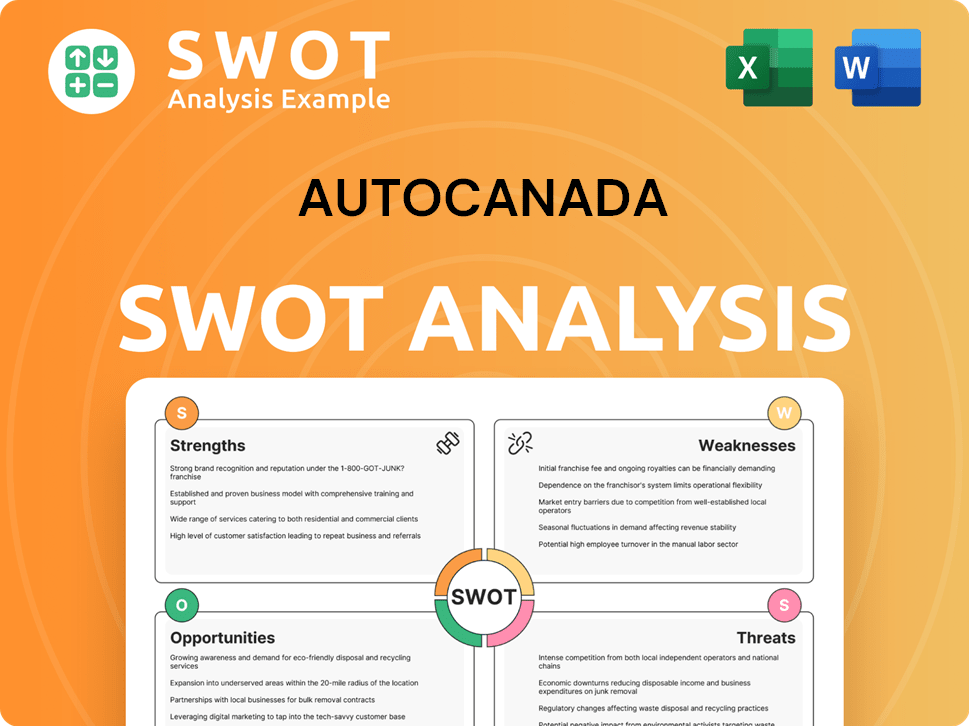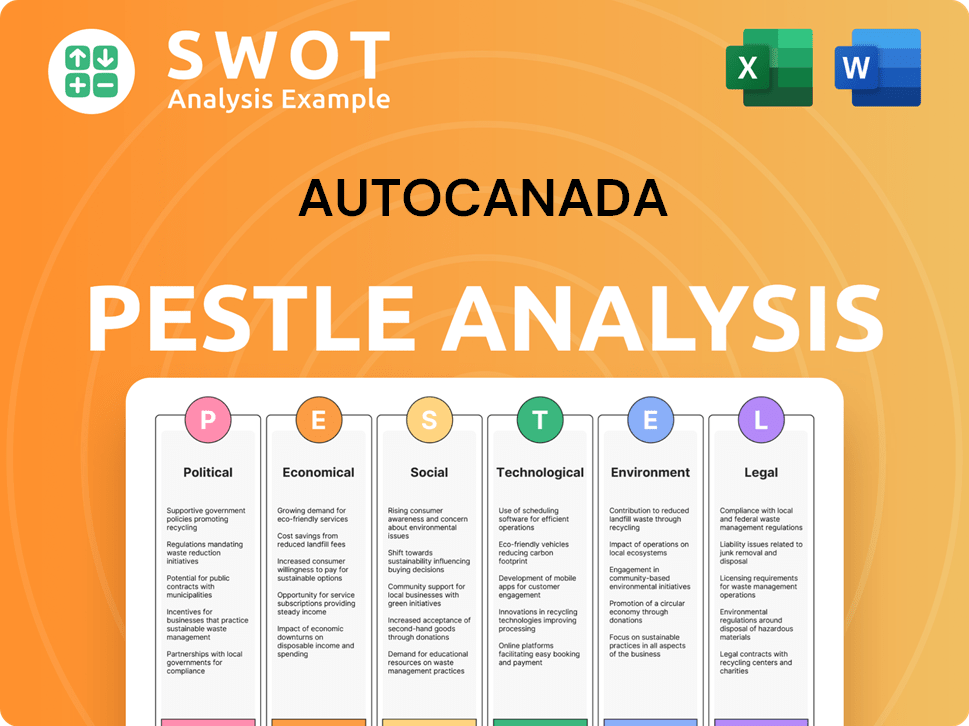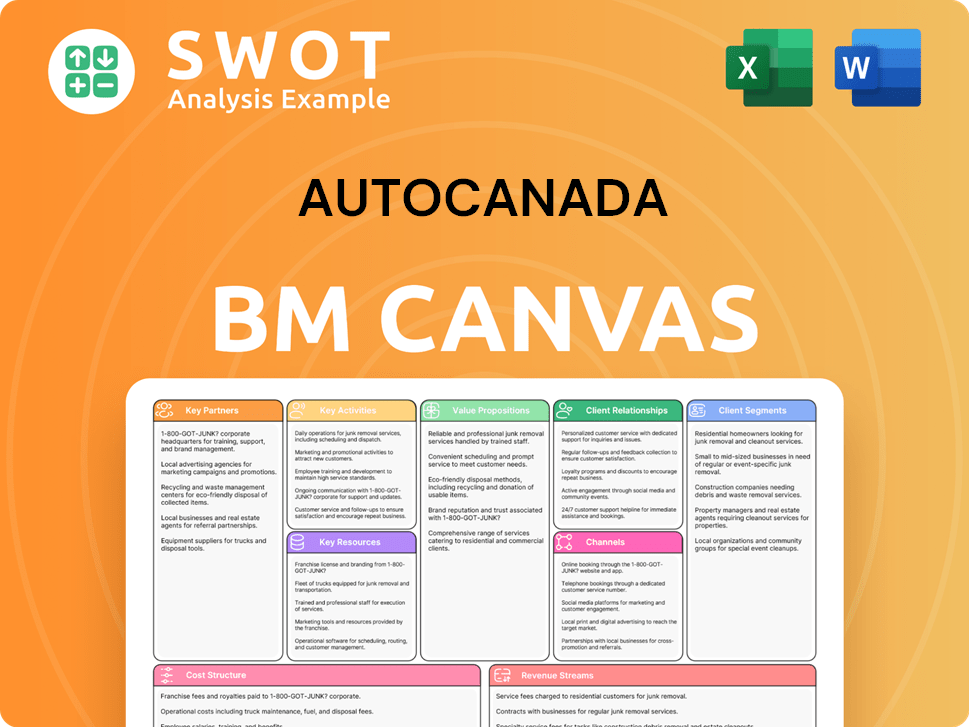AutoCanada Bundle
Unveiling AutoCanada: How Does It Drive Success?
AutoCanada, a major player in the North American automotive retail sector, operates a vast network of car dealerships across Canada. With over $5.3 billion in revenue generated in 2024, understanding the inner workings of AutoCanada is key for anyone interested in the Canadian automotive industry. This deep dive explores the company's operational strategies and financial performance, offering valuable insights into its business model.

From its extensive network of franchised dealerships selling new and used vehicles to its strategic focus on operational efficiencies, AutoCanada's success is multifaceted. This analysis will examine the company's revenue streams, competitive advantages, and the challenges it faces in the evolving market. For a deeper understanding of AutoCanada's strategic positioning, consider exploring the AutoCanada SWOT Analysis to gain a comprehensive perspective on its strengths, weaknesses, opportunities, and threats. This will help you understand how AutoCanada operations contribute to its overall financial performance.
What Are the Key Operations Driving AutoCanada’s Success?
The core of AutoCanada's operations revolves around its comprehensive automotive retail business model. This model encompasses new and used vehicle sales, alongside automotive service, repair, and parts. With a network of dealerships and service centers, AutoCanada aims to provide a full suite of services to its customers, enhancing customer loyalty and generating recurring revenue.
AutoCanada's value proposition is centered on offering a wide selection of vehicles and services to meet diverse customer needs. The company operates numerous franchises representing various automotive brands, catering to a broad customer base. This approach, combined with its focus on operational efficiency, allows AutoCanada to offer competitive pricing and a superior customer experience.
The company's operational processes are designed to support these diverse offerings. For new vehicle sales, AutoCanada leverages its franchised dealerships to provide a wide range of brands, appealing to varying customer preferences. Used vehicle sales are supported by dedicated dealerships and an auction business. The company's parts and service operations, including collision centers, cater to vehicle maintenance and repair needs, enhancing customer retention and providing recurring revenue streams.
AutoCanada operates 64 new light vehicle OEM franchises, representing 25 automotive brands. This extensive network allows the company to offer a wide selection of vehicles to customers. These dealerships are crucial for new vehicle sales and customer service, forming a key part of the AutoCanada business model.
Used car sales are a significant part of AutoCanada's revenue stream. The company manages used retail operations and leverages its auction business to source and sell vehicles. This segment provides customers with a range of options, contributing to the overall financial performance of AutoCanada.
AutoCanada's service operations include 29 collision centers, supporting vehicle maintenance and repair needs. These services enhance customer retention and provide recurring revenue. A dedicated business development center (BDC) for service departments in Canadian dealerships centralizes booking and aims to increase profitability through operational efficiency.
AutoCanada focuses on providing a comprehensive range of vehicle options and services. The multi-location dealership model offers benefits not available to single-location dealerships, such as a diversified geographic customer base. This approach aims to enhance customer satisfaction and build long-term relationships.
AutoCanada's operations are unique due to its multi-location dealership model, providing a diversified customer base. The company's ability to offer multiple financing sources, extended warranties, and access to dealer auctions provides a competitive edge.
- Multi-Location Model: Diversifies the customer base and provides broader market reach.
- Financing and Warranties: Offers flexible financing options and extended warranties to attract customers.
- Dealer Auctions: Enables competitive pricing and efficient inventory management.
- Operational Efficiency: Initiatives like the 'ACX Operating Method' streamline operations and improve profitability.
AutoCanada SWOT Analysis
- Complete SWOT Breakdown
- Fully Customizable
- Editable in Excel & Word
- Professional Formatting
- Investor-Ready Format

How Does AutoCanada Make Money?
Understanding the revenue streams and monetization strategies of AutoCanada is crucial for grasping its financial performance and overall business model. AutoCanada, a prominent player in the Canadian automotive industry, generates revenue from a variety of sources, including new and used vehicle sales, parts and service, collision repair, and finance and insurance (F&I) products. The company's ability to effectively manage these revenue streams is key to its success.
AutoCanada's operations are designed to maximize profitability through a comprehensive approach. This includes leveraging its extensive network of car dealerships Canada to offer a wide range of products and services. The company's focus on optimizing cost structures and improving inventory management further enhances its financial outlook. For a deeper dive into the company's origins, you can explore the Brief History of AutoCanada.
In Q4 2024, AutoCanada reported revenue of $1.3 billion from continuing operations, experiencing a slight decrease of 1.2% year-over-year. However, Q1 2025 saw a positive shift, with revenue increasing by 2.3% year-over-year to $1.22 billion. The company generated over $5.3 billion in total revenue in 2024.
AutoCanada's revenue is derived from several key areas, each contributing differently to its overall financial performance. Understanding these segments provides insight into the company's strategic focus and market positioning within the Canadian automotive industry.
- New Vehicle Sales: This remains a primary revenue driver. In Q4 2024, new vehicle unit sales grew by 4.7% year-over-year, although gross profit per retail unit decreased by 14.3%.
- Used Vehicle Sales: Used car sales experienced an 8.4% decline in Q4 2024, due to inventory mix challenges and industry normalization.
- Parts and Service (P&S) and Collision Repair: These segments are significant contributors to gross profit. P&S gross profit increased by 1.0% in Q4 2024, and the collision business showed strong performance in Q1 2025.
- Finance and Insurance (F&I): AutoCanada offers third-party lease and finance products, extended warranties, and other related products. F&I gross profit per retail unit increased by 1.9% in Q4 2024. However, there's a trend away from more profitable bank finance deals.
AutoCanada PESTLE Analysis
- Covers All 6 PESTLE Categories
- No Research Needed – Save Hours of Work
- Built by Experts, Trusted by Consultants
- Instant Download, Ready to Use
- 100% Editable, Fully Customizable

Which Strategic Decisions Have Shaped AutoCanada’s Business Model?
The [Company Name] has undergone significant strategic shifts, particularly in 2024 and 2025, impacting its operations and financial performance. A key milestone was the launch of a transformation plan in Q3 2024, in collaboration with Bain & Company. This initiative aimed to achieve substantial cost savings, targeting $100 million in annual run-rate savings by the end of 2025. The company's focus remains on streamlining operations and enhancing profitability within the Canadian automotive market.
As of Q1 2025, the transformation plan has yielded significant results. The company has achieved $57.1 million in annualized run-rate savings. This includes $48.1 million added in Q1 2025 alone, demonstrating the plan's effectiveness in driving operational efficiencies. These savings are crucial for improving the company's financial health and competitive position within the Canadian automotive industry.
The company's strategic moves include divesting non-core assets and streamlining its business model. These actions are designed to strengthen its core operations and focus on the Canadian market. The company's ability to adapt and respond to market dynamics is a key factor in its long-term success.
The transformation plan launched in Q3 2024, in partnership with Bain & Company, is a central initiative. The goal is to achieve $100 million in annual run-rate cost savings by the end of 2025. As of Q1 2025, the company has realized $57.1 million in annualized run-rate savings.
The company divested non-core assets, including three Stellantis dealerships, generating $59.5 million in net proceeds. It closed all RightRide locations, eliminating an $11 million annual adjusted EBITDA loss in 2024. The U.S. business was reclassified as a discontinued operation as of December 31, 2024.
The company benefits from its scale as the largest publicly listed automobile group in Canada. It has a diverse vehicle portfolio with 25 automotive brands and a broad geographic presence across eight Canadian provinces. Technology integration, using platforms like AudioEye, Amazon Web Services, and Salesforce, enhances customer experience.
The sale of non-core assets brought in $59.5 million in net proceeds. Closing RightRide eliminated an $11 million annual adjusted EBITDA loss in 2024. The U.S. business, which had a $24.2 million adjusted EBITDA loss in 2024, is being divested. The company is focused on improving its financial performance.
The company's strategic moves are centered on enhancing its core Canadian dealership and collision operations. This involves divesting non-core assets and streamlining its business model to concentrate on more profitable areas. The transformation plan emphasizes cost optimization and operational efficiency to improve financial performance.
- Divestment of non-core assets to focus on core operations.
- Closure of RightRide locations to eliminate losses.
- Reclassification of the U.S. business as a discontinued operation.
- Ongoing technology integration to enhance customer experience.
AutoCanada Business Model Canvas
- Complete 9-Block Business Model Canvas
- Effortlessly Communicate Your Business Strategy
- Investor-Ready BMC Format
- 100% Editable and Customizable
- Clear and Structured Layout

How Is AutoCanada Positioning Itself for Continued Success?
As the largest and only publicly listed automobile group in Canada, AutoCanada holds a leading position in the Canadian automotive retail industry. With 64 new light vehicle OEM franchises and 29 collision centers across eight provinces, the company is a significant player in the market. The Canadian new light vehicle market saw robust growth in 2024, with sales reaching 1.86 million units, an 8.2% increase year-over-year.
However, the company faces several risks and uncertainties. The automotive industry is susceptible to economic downturns and shifts in consumer sentiment. Potential U.S. tariffs introduce significant uncertainty, impacting sales and profitability. Furthermore, volatility in the used car market and increasing financial leverage pose additional challenges for the company.
AutoCanada is the largest and only publicly listed automobile group in Canada. It operates 64 new light vehicle OEM franchises and 29 collision centers across eight provinces. The company's strong market position is crucial for its operations.
Key risks include economic uncertainty, tariff risks, and used car market volatility. Weakening consumer sentiment and inflationary pressures could impact demand. Increasing financial leverage, reaching 5.5x total net funded debt to bank EBITDA in Q1 2025, poses a challenge.
AutoCanada is committed to achieving $100 million in annual run-rate cost savings by the end of 2025. The company plans to divest its U.S. business by the end of 2025. Leadership focuses on managing risk and preserving cash.
The company's financial leverage has been increasing, reaching 5.5x total net funded debt to bank EBITDA in Q1 2025, up from 4.9x in Q4 2024. The goal is to reduce leverage to 2-3 times EBITDA. Additional cost savings are anticipated in 2026.
AutoCanada's strategic initiatives include a transformation plan focused on cost optimization and operational refinement. The divestiture of the U.S. business is a key part of this strategy. The company is aiming to strengthen its financial position.
- Cost Savings: Targeting $100 million in annual run-rate cost savings by the end of 2025.
- Divestiture: Planned sale of the U.S. business to concentrate on Canadian operations.
- Financial Discipline: Focus on managing risk, preserving cash, and reducing leverage.
- Market Focus: Prioritizing the more profitable Canadian automotive industry.
AutoCanada Porter's Five Forces Analysis
- Covers All 5 Competitive Forces in Detail
- Structured for Consultants, Students, and Founders
- 100% Editable in Microsoft Word & Excel
- Instant Digital Download – Use Immediately
- Compatible with Mac & PC – Fully Unlocked

Related Blogs
- What are Mission Vision & Core Values of AutoCanada Company?
- What is Competitive Landscape of AutoCanada Company?
- What is Growth Strategy and Future Prospects of AutoCanada Company?
- What is Sales and Marketing Strategy of AutoCanada Company?
- What is Brief History of AutoCanada Company?
- Who Owns AutoCanada Company?
- What is Customer Demographics and Target Market of AutoCanada Company?
Disclaimer
All information, articles, and product details provided on this website are for general informational and educational purposes only. We do not claim any ownership over, nor do we intend to infringe upon, any trademarks, copyrights, logos, brand names, or other intellectual property mentioned or depicted on this site. Such intellectual property remains the property of its respective owners, and any references here are made solely for identification or informational purposes, without implying any affiliation, endorsement, or partnership.
We make no representations or warranties, express or implied, regarding the accuracy, completeness, or suitability of any content or products presented. Nothing on this website should be construed as legal, tax, investment, financial, medical, or other professional advice. In addition, no part of this site—including articles or product references—constitutes a solicitation, recommendation, endorsement, advertisement, or offer to buy or sell any securities, franchises, or other financial instruments, particularly in jurisdictions where such activity would be unlawful.
All content is of a general nature and may not address the specific circumstances of any individual or entity. It is not a substitute for professional advice or services. Any actions you take based on the information provided here are strictly at your own risk. You accept full responsibility for any decisions or outcomes arising from your use of this website and agree to release us from any liability in connection with your use of, or reliance upon, the content or products found herein.